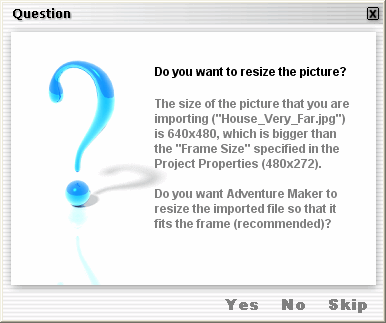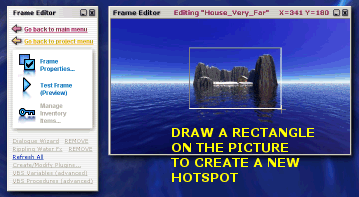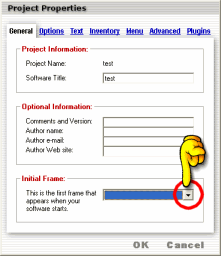CREATING
SOFTWARE FOR PSP
I. Overview
 In addition to creating
software for Windows, Adventure Maker Free Edition (v4.1
or newer) is capable of creating software that can be played on the PSP (firmware 2.x or newer). No scripting or programming is
required. The created software is safe HTML-based software that does not
require any system modification or hack of any kind. In addition to creating
software for Windows, Adventure Maker Free Edition (v4.1
or newer) is capable of creating software that can be played on the PSP (firmware 2.x or newer). No scripting or programming is
required. The created software is safe HTML-based software that does not
require any system modification or hack of any kind.
Adventure
Maker is able to generate an
installer for the PSP,
so that the software is copied locally
to the PSP memory card and runs without an Internet connection
(more details in section III.).
What you can create with this version of Adventure Maker is any
software that
involves static pictures, pre-rendered animations, and simple point-and-click puzzles. Here are some examples:
- first-person adventure games
- interactive magazines
- interactive visits (museums, sites...)
- trivia games
- educational software
- tour guides
- interactive presentations and brochures
- interactive comics
- other point-and-click software
For example, take photos of your house, and
let people visit it by clicking on the doors and on other hotspots. Or, create a tour
guide (of a museum, a site, or a shop), and tell people to bring
the PSP with them when visiting the site, so that they can get more
information on what they see. Or, make some hand drawings, and then
create an interactive comic. Or, create an interactive magazine. And so on... You will find many more ideas by having a look
at the games created by other
people.
Please note that NOT all the features of
Adventure Maker are currently supported. Unlike the compiler for Windows,
the compiler for PSP does not allow you to create 360-degree interactive panoramas or third-person
games. Many other features are also currently not supported (audio, inventory,
savegames...
read the section "what features are supported?"
below for more information),
but it is possible that they will be supported in future
updates of Adventure Maker.
II.
Are there examples of created games?
Yes, there are many free games and demos created with
Adventure Maker that are available for download. Just visit the following page:
http://www.adventuremaker.com/games.htm
Those are compiled games,
meaning that you can play them, but you cannot see how they
were actually created.
To see what the source of a game looks like, you should have
a look at the sample game that is included in the Adventure Maker package.
It is called "Sample game for PSP" (or
"Portable game demo"), and you can open it by doing the
following:
1. Launch Adventure Maker (Free Edition)
2. Click "Load Project..."
3. Click "Jump to the projects folder"
4. Select "Sample game for PSP"
5. Click OK.
That sample game was specially created for the
PSP, meaning that you can directly compile it (just click "Compile"
from the Project Menu), and play it on the PSP.
Note: You will notice that the Adventure Maker package also
contains several other sample games. Those games are designed for Windows or
for other platforms, and therefore they cannot be
compiled for the PSP.
III. How can I create my own game?
Creating a game with Adventure Maker is very simple. You
don't need to know any programming language, because everything is done with mouse clicks.
Before starting using Adventure Maker, you should think of
what type of game you want to create, and you should create the images for it.
For example, if you want to create an adventure game inside
your house, you should take photos of your rooms. If you want to create a sci-fi adventure
game, you should create 3D-rendered graphics, or make some drawings (if you decide to do
so, make sure to try out the free utility called "Creative Painter" included in
the Adventure Maker package). More ideas for creating pictures are available on the creating pictures page.
Once you have your pictures, you can start using Adventure
Maker to put them together. The general steps are very simple (for a more detailed
tutorial, read the section "complete tutorial for creating your first game"
below):
1. Start Adventure Maker,
2. Create a new project,
3. A window will appear asking you to choose the "target platform"
(see screenshot below). Make sure to select "PSP"
before clicking OK:

4. Import your pictures (by clicking "Create
New Frames"),
5. Edit the newly created frames by double-clicking on the corresponding
thumbnails, and add hotspots to link them to one another,
6. Optionally, create puzzles with hotspots being enabled or
disabled and pictures being hidden or shown depending on the value of some variables (read
the next section for details),
7. Go to the Project Properties and choose the "initial frame"
(i.e. the first picture that appears when the game starts),
8. Click "COMPILE for PSP".
The compiler will generate a set of files that you can
redistribute for free (if you are using Adventure Maker Free Edition), or for profit (if
you have purchased the "Full Edition for commercial-use").
Among the generated files, you will notice that there is a
Setup.exe file. It automatically detects the PSP, and
installs the software on it (to see it in action, download a sample compiled game). The
Setup file requires the VB6 runtimes to run, but these are included by default in Windows
XP, so you don't need to distribute them. For older operating systems, you may want to
link to this
page, which contains an updated link to a place where people can download the VB6 runtimes
(1MB).
Legal
note: If you plan to
make money with the software that you have created (directly - through sales -
or indirectly - through advertising for example), be sure to buy "Adventure
Maker Full Edition for Commercial Use" registered at your name. You cannot use the Free
Edition to make money.
For a more detailed tutorial, please read
the section "complete tutorial for creating your first game".
IV.
How can I create simple puzzles?
To create simple puzzles, you can use the two options that
are under the "Variables" tab of the "Hotspot Properties",
which allow you for each hotspot to:
- change the value of one or more variables
when the player clicks on the hotspot,
- enable/disable the hotspot (if the hotspot is
transparent) or show/hide the hotspot (if the hotspot contains a picture)
depending on the value of one or more variables.
Surprisingly enough, with only those two simple options it is
possible to create puzzles as complicate as those found in most commercial first-person
adventure games. You just need to spend a few minutes getting used to them. Try
experimenting with them, and try also understanding how the sample game included in the
package works.
V.
What features are supported?
This is what you CAN do with the current
version of the compiler for PSP:
- Move from frame to frame.
- Display cursors
- Use variables to create puzzles (all the options under the "variables" tab
of the Hotspot Properties are supported).
- Use both transparent and graphical hotspots.
- Display text messages at the bottom of the screen.
- Use timers to go to another frame after X seconds (from the Frame
Properties window).
- Use animated GIF's.
This is what you CANNOT do with the current
version of the compiler for PSP
- Play sounds
- Use the inventory (instead, you can use a variable
to remember whether the item was picked up or not:
see the sample game for an example)
- Create savegames
- Play videos (use animated GIF's instead)
- Display text at any position of the frame (the text that you create by
right-clicking on a frame)
- Use VBScript
- Use plugins (3rd person plugin, panoramas, etc.)
- All the other advanced features.
VI. Complete tutorial for creating your first game
This tutorial will use the three following pictures that are
included in the Adventure Maker package, inside the "Tutorial Graphics"
folder of Adventure Maker:
 - House_Near.jpg - House_Near.jpg
- House_Far.jpg
- House_Very_Far.jpg
These three pictures are 3D-rendered pictures,
created with Bryce 5. In your games, you have the possibility to use any kind of pictures
(JPEG or GIF), including drawings or photos taken with a digital camera. Click here for more information on how to create your pictures.
|
 1. Run Adventure Maker
v4.1 or newer (any edition). 1. Run Adventure Maker
v4.1 or newer (any edition).
2. Click "New Project...".
3. Enter a project name and then click OK.
4. An "information" window will
appear. Click Continue to close the information window.
5.
A window will appear asking you to choose the "target platform".
Select "PSP" and then click OK, as shown in the
following screenshot:

6. An
"information" window will appear. Click Continue to close the
information window.
7. The Frames Management window will appear. Click "Create New Frames (by importing pictures)",
as shown in the following screenshot:

8. A file selection window
will popup. Make sure that the current folder is "Tutorial Graphics" (located
inside the Adventure Maker folder). Then select the three following files
(you must select all of them at once):
- House_Near.jpg
- House_Far.jpg
- House_Very_Far.jpg
Note: to select the three
files, you can hold down the Ctrl key while single-clicking on them.
Make sure that the three
files are selected, and then click the Open button to continue.
9. You will see several of
the following questions, one for each of the imported picture:

Make sure to always click
"Yes" when such a question pops up. Normally, the question
should pop up three times, because you are importing three pictures.
10. Three thumbnails should
have appeared inside the Frames Management window. Double-click the
thumbnail named "House_Very_Far":

11. The picture of the
island with the sea should appear. In order to create a new hotspot, create
a selection over the island. The selection should have the size of the
island.
Note: to create a selection,
just draw a rectangle as if you were using a drawing utility (hold down the left mouse
button, drag, and then release the button), as shown in the following screenshot:

12. The "Hotspot Properties" window
will appear. To choose the appearance of the mouse pointer when the player moves it over
the island, click the button "Click here to change..." under
the text "Cursor when over the hotspot".
13. A cursor selection window will pop up. Double-click
the icon named "p_up1.ico".
14. You will be brought back to the
"Hotspot Properties" window. Now click the option "Go to another
frame" that is under the "Hyperlink" section.
15. The frame selection window will appear (if
it does not appear automatically, click the button "Click to choose a
frame..."). Single-click on the thumbnail named "House_Far"
in order to create the hyperlink.
16. Now click OK to close the
"Hotspot Properties" window.
17. Click the link "Go back to
project menu" that is at the top-left corner of the screen, as show in the
following screenshot:

18. Now double-click the thumbnail named
"House_Far", and do the same as you did with the frame
"House_Very_Far" (repeat exactly the steps 12, 13, 14 and 15).
19. The goal is to create a hotspot that allows
getting closer to the house. So, this time, when the frame selection window appears,
single-click on the thumbnail named "House_Near" (instead of
single-clicking on the thumbnail named "House_Far" as you did at step 16).
20. Click OK to close the
"Hotspot Properties" window.
21. Click the link "Go back to
project menu" that is at the top-left corner of the screen.
22. In order to choose which picture must appear
when the game starts, click "Project Properties...", and then
select "House_Very_Far" under the "initial frame"
section:

Then click OK to close the
"Project Properties" window.
23. Click "Run Project (Start)..."
to test your game. You can move towards the house by clicking on the house.
24. To quit the game, you can either press
Ctrl+Q, or click "Exit" from the menu at the top of the game
area.
NOTE: In order to be able to walk backward
(currently you can only walk forward), you should create some large hotspots at the bottom
of each picture, and link them to the parent pictures.
25. Now click "COMPILE
for PSP" to create a package that is ready for distribution:

26. You will be asked to choose the folder where
you want to save the compiled files. For example, choose the desktop, and click OK.
27. Wait for the compilation to finish. When the
compilation is finished, you should see the following message:

Click "Open with explorer"
to see the compiled files.
28. The files are ready for distribution. In
order to easily distribute them on the Internet, it is recommended that you compress
them into a ZIP archive.
This is the end of the tutorial.
To advertise your games for free on the games page of Adventure Maker website, please feel free to tell
us about them.
VII.
Two pictures that you can use in your software
In order to tell the users
how to play the software, please feel free to include the two following
pictures in your software (click "Create New Frames..." to import them into
Adventure Maker, and then create hotspots over the text "Click here to
continue" in order to create hyperlinks). You can also modify them with a
program such as Paint, to better fit your needs.


VIII.
Example of "Readme" file for your software
When you
distribute your
software, it is recommended that you include a text file named "_Readme.txt"
that contains some useful information about the software.
Below is an example of
typical "_Readme.txt" file. Please feel free to copy/paste it into a new
text document, and to modify it to fit your needs (replace
"MY_SOFTWARE" with the name of your software):
-------------------------------------------
MY_SOFTWARE V1.0
FOR LEGAL 2.X PORTABLE GAMING SYSTEM
Release date:
FILL THIS FIELD
Created by: FILL THIS FIELD
Website: FILL THIS FIELD
Email: FILL THIS FIELD
-------------------------------------------
---------------------
SOFTWARE DESCRIPTION:
---------------------
INSERT THE SOFTWARE DESCRIPTION HERE
MY_SOFTWARE is compatible with any legal 2.x portable gaming
system. It is safe HTML-based software that does not require any system
modification or hack of any kind.
------------------------
TO INSTALL THE SOFTWARE:
------------------------
1. Connect the portable gaming system to the PC using the USB cable
2. Start the program "_Setup.exe" that is bundled with the software
3. Follow the on-screen instructions.
Note 1: The Setup program is compatible with WindowsXP. If you have an
older operating system, you may need to install the VB6 runtimes, which
you can download from the following URL:
http://www.adventuremaker.com/more_downloads.htm
Note 2: Here is what the Setup program does: it automatically detects
the portable gaming system, and then simply copy the software files to
the memory card, and add an entry to the bookmarks so that you can play
the software from the Internet Browser of the portable gaming system. No
system modification is required.
-----------------------
TO LAUNCH THE SOFTWARE:
-----------------------
1. Launch the Internet Browser on the portable gaming system
2. Go to the bookmarks, open "My Bookmarks"
3. Open the bookmark named "MY_SOFTWARE".
---------
CONTROLS:
---------
- Move the cursor with the analog stick
- Use the X button to click.
------------------------
FOR THE BEST EXPERIENCE:
------------------------
- The "Text Size" and the "Display Mode" (from the "View" menu of the
Internet Browser) must be both set to "Normal".
- All the options under the "View Settings" (from the "Tools" menu) must
be enabled (images, animations, and JavaScript)
- Do not use the L and R transparent buttons located at the top of the
portable gaming system.
---------------------------
TO UNINSTALL THE SOFTWARE:
---------------------------
Simply remove the folder named "MY_SOFTWARE"
that is located inside the "INSTALLED_SOFTWARE" folder of the memory
card, and remove the entry that was added to the bookmarks.
----------------------
ABOUT ADVENTURE MAKER:
----------------------
MY_SOFTWARE was created with
Adventure Maker Free Edition, which is a software creation toolkit that
does not require any scripting or programming. You can download it from
the following URL:
http://www.adventuremaker.com
--------------------
WARRANTY DISCLAIMER:
--------------------
THIS PROGRAM IS PROVIDED "AS-IS" AND WITHOUT WARRANTY OF ANY KIND.
All trademarks are the property of
their respective owners. |
IX. Legal
"PSP"
is a trademark of Sony Computer Entertainment Inc. As of the release date of
this version, Adventure Maker is NOT affiliated with,
endorsed by, or sponsored by Sony, SCEI, or any other Sony subsidiary.
|
